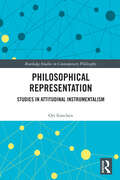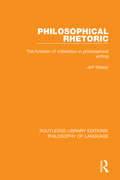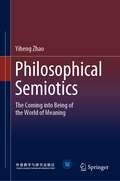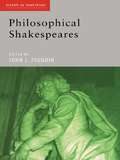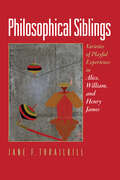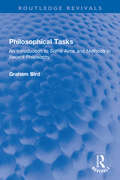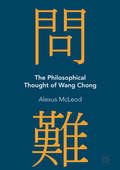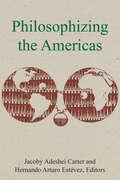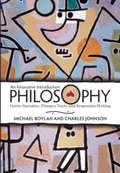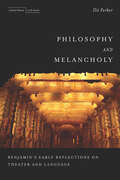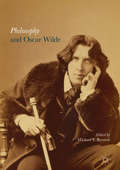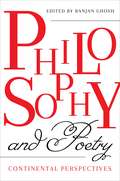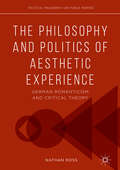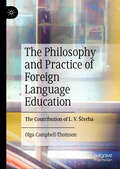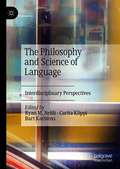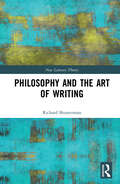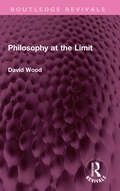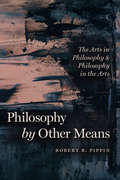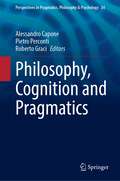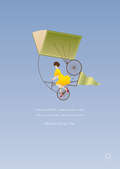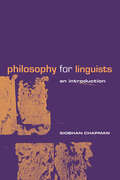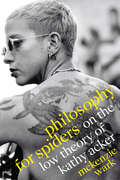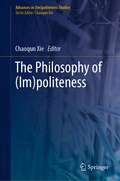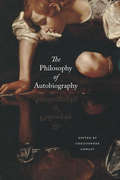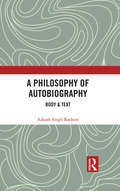- Table View
- List View
Philosophical Representation: Studies in Attitudinal Instrumentalism (Routledge Studies in Contemporary Philosophy)
by Ori SimchenThis book focuses on how we should treat philosophy’s theoretical representations. It argues in favor of an instrumentalist attitude towards pivotal cases of theoretical representation in philosophy that are commonly regarded under a realist attitude. Philosophy is awash with theoretical representations, which raises the question of how we should regard them. This book argues that representations in philosophy should not be regarded under a realist attitude by default as individually disclosing the nature of what they represent. Ori Simchen introduces the reader to the general theme of representations in philosophy and our attitudes towards them via case studies: numbers, modality, and belief. He offers a framework for deciding when a realist attitude towards a theoretical representation is warranted and concludes that the representations deployed in the case studies fail the proposed test. The next part of the book illustrates the attractiveness of attitudinal instrumentalism towards representations in semantics, in the philosophy of mind, and within the problematics of rule-following. Philosophical Representation will appeal to researchers and advanced students working in philosophy of language, philosophy of mind, metaphysics, philosophical logic, and philosophical methodology.
Philosophical Rhetoric: The Function of Indirection in Philosophical Writing
by Jeff MasonThis book, originally published in 1989 discusses an issue central to all philosophical argument – the relation between persuasion and truth. The techniques of persuasion are indirect and not always fully transparent. Whether philosophers and theoreticians are for or against the use of rhetoric, they engage in rhetorical practice none the less. Focusing on Plato, Descartes, Kant, Kierkegaard, Nietzsche and Wittgenstein, this book uncovers philosophical rhetoric at work and reminds us of the rhetorical arena in which philosophical writings are produced and considered.
Philosophical Semiotics: The Coming into Being of the World of Meaning
by Yiheng ZhaoThis book attempts to solve the question whether semiotics is a methodology as is generally held and if the studies of meaning and the mind can shed light on a series of metaphysical issues, so that the edifice of semiotics could be erected on a philosophical ground. It proposes that a philosophical semiotics is, by necessity, a semiotic phenomenology about the construction of the “world of meaning” by signs, and any discussion about semiotics has to proceed around two core issues: meaning and the mind.This book particularly exemplifies the semiotic connections in various schools of traditional Chinese philosophies. In the “Pre-Imperial Age” (before BC 300), there emerged an abundance of semiotic thinking in China, from Yijing the first sign system that aims to explain everything in the world, to the Namists’s subtle argument about the form of meaning, from the Yin-Yang/five elements of the Han, to the “Things are non-existent while mind is non-non-existent” principle of the Vijñāptimātratāsiddhi School of Buddhism in the Tang, and from the Sudden Revelation of Chan Buddhism to the “Nothing outside the mind” endorsed by the Mindist Confucianism in the Ming. The mighty trend of philosophical heritage provides rich food to our understanding of the form of meaning.
Philosophical Shakespeares (Accents on Shakespeare)
by John J. JoughinShakespeare continues to articulate the central problems of our intellectual inheritance. The plays of a Renaissance playwright still seem to be fundamental to our understanding and experience of modernity.Key philosophical questions concerning value, meaning and justice continue to resonate in Shakespeare's work. In the course of rethinking these issues, Philosophical Shakespeares actively encourages the growing dissolution of boundaries between literature and philosophy. The approach throughout is interdisciplinary, and ranges from problem-centred readings of particular plays to more general elaborations of the significance of Shakespeare in relation to individual thinkers or philosophical traditions.
Philosophical Siblings: Varieties of Playful Experience in Alice, William, and Henry James
by Jane F. ThrailkillAlice James: an exemplary nineteenth-century neurasthenic and diarist. William James: a foundational figure for American psychology and philosophy. Henry James: a preeminent author and literary critic. These three iconic figures of nineteenth-century American culture and letters were also siblings, children of the storied James family, yet the diarist, the psychologist, and the novelist have seemed to occupy distinct realms of cultural authority and to speak to different audiences (or, in the case of Alice, to no audience at all). Their writings have rarely been considered together.In Philosophical Siblings Jane F. Thrailkill asks what new story is illuminated when we study their writings collectively. By approaching the Jameses as intimate thinkers operating on a common field of play, Thrailkill reveals the siblings' shared project—part psychological, part philosophical—of showing how minds meet in a world teeming with possibilities and risks. Scientists in nineteenth-century psychology labs were studying isolated individuals, tracking eye movements, and timing reactions to better understand the human machine. In contrast, the Jameses' models for discovery were philosophical toys: ludic devices that light up quirks of perception and are devilishly fun as well. With childlike humor, the siblings' intellectual playfulness is both message and medium, manifested in an expressive style that exploits incongruity, delights in absurdities, and sometimes, teasingly, inflicts the sting of critique.Most important, the Jameses' writings model how human beings accomplish high-wire acts of perception and creation. Alice, William, and Henry James did not merely present a new, interactive theory of mind; they dramatized it in their writings as a curiosity-based practice. Philosophical Siblings accepts their invitation to mindful play and offers a fresh way of thinking about literary encounters more generally, one that approaches even the weightiest texts with serious lightness.
Philosophical Tasks: An Introduction to Some Aims and Methods in Recent Philosophy (Routledge Revivals)
by Graham BirdFirst published in 1972, Philosophical Tasks was written to identify and examine some central themes in contemporary Anglo-American philosophy. The book explores the claim that philosophy is essentially linguistic, and considers in particular such topics as philosophy and science, fact and language, conceptual analysis, first- and second-order tasks, scepticism, ordinary language, and conceptual frameworks.
The Philosophical Thought of Wang Chong
by Alexus McLeodThis book is a study of the methodological, metaphysical, and epistemological work of the Eastern Han Dynasty period scholar Wang Chong. It presents Wang’s philosophical thought as a unique and syncretic culmination of a number of ideas developed in earlier Han and Warring States philosophy. Wang’s philosophical methodology and his theories of truth, knowledge, and will and determinism offer solutions to a number of problems in the early Chinese tradition. His views also have much to offer contemporary philosophy, suggesting new ways of thinking about familiar problems. While Wang is best known as a critic and skeptic, Alexus McLeod argues that these aspects of his thought form only a part of a larger positive project, aimed at discerning truth in a variety of senses.
Philosophizing the Americas
by Jacoby Adeshei Carter and Hernando A. EstévezPhilosophizing the Americas establishes the field of inter-American philosophy. Bringing together contributors who work in Africana Philosophy, Afro-Caribbean philosophy, Latin American philosophy, Afro-Latin philosophy, decolonial theory, and African American philosophy, the volume examines the full range of traditions that have, separately and in conversation with each other, worked through how philosophy in both establishes itself in the Americas and engages with the world from which it emerges.The book traces a range of questions, from the history of philosophy in the Americas to philosophical questions of race, feminism, racial eliminativism, creolization, epistemology, coloniality, aesthetics, and literature. The essays place an impressive range of philosophical traditions and figures into dialogue with one another: some familiar, such as José Martí, Sylvia Wynter, Martin R. Delany, José Vasconcelos, Alain Locke, as well as such less familiar thinkers as Arturo Alfonso Schomburg, Hilda Hilst, and George Lamming. In each chapter, the contributors find fascinating and productive matrices of tension or convergence in works throughout the Americas. The result is an original and important contribution to knowledge that introduces readers from various disciplines to unfamiliar yet compelling ideas and considers familiar texts from novel and prescient perspectives. Philosophizing the Americas stands alone as a representation of current scholarly debates in the field of inter-American philosophy.
Philosophy
by Charles Johnson Michael BoylanAn innovative introductory philosophy text that combines traditional readings and writing exercises with fictive narratives about central figures in the history of philosophy.
Philosophy and Melancholy: Benjamin's Early Reflections on Theater and Language
by Ilit FerberThis book traces the concept of melancholy in Walter Benjamin's early writings. Rather than focusing on the overtly melancholic subject matter of Benjamin's work or the unhappy circumstances of his own fate, Ferber considers the concept's implications for his philosophy. Informed by Heidegger's discussion of moods and their importance for philosophical thought, she contends that a melancholic mood is the organizing principle or structure of Benjamin's early metaphysics and ontology. Her novel analysis of Benjamin's arguments about theater and language features a discussion of theTrauerspielbook that is amongst the first in English to scrutinize the baroque plays themselves. Philosophy and Melancholyalso contributes to the history of philosophy by establishing a strong relationship between Benjamin and other philosophers, including Leibniz, Kant, Husserl, and Heidegger.
Philosophy and Oscar Wilde
by Michael Y. BennettThis book is the first collection of essays to discuss Oscar Wilde’s love and vast knowledge of philosophy. Over the past few decades, Oscar Wilde scholars have become increasingly aware of Wilde’s love and intimate knowledge of philosophy. Wilde’s “Oxford Notebooks” and his soon-to-be-published “Notebook on Philosophy” all point to Wilde not just as an aesthete, but also as a serious philosophical thinker. The aim of this collection is not to make the statement that Wilde was a philosopher, or that his works were philosophical tracts. Rather, it provides a space to explore any and all linkages between Wilde’s works and philosophical thought. Addressing a broad spectrum of philosophical matter, from classical philology to Daoism, ethics to aestheticism, this collection enriches the literature on Wilde and philosophy alike.
Philosophy and Poetry: Continental Perspectives
by Ranjan GhoshEver since Plato’s Socrates exiled the poets from the ideal city in The Republic, Western thought has insisted on a strict demarcation between philosophy and poetry. Yet might their long-standing quarrel hide deeper affinities? This book explores the distinctive ways in which twentieth-century and contemporary continental thinkers have engaged with poetry and its contribution to philosophical meaning making, challenging us to rethink how philosophy has been changed through its encounters with poetry.In wide-ranging reflections on thinkers such as Heidegger, Gadamer, Arendt, Lacan, Merleau-Ponty, Deleuze, Irigaray, Badiou, Kristeva, and Agamben, among others, distinguished contributors consider how different philosophers encountered the force and intensity of poetry and the negotiations that took place as they sought resolutions of the quarrel. Instead of a clash between competing worldviews, they figured the relationship between philosophy and poetry as one of productive mutuality, leading toward new modes of thinking and understanding. Spanning a range of issues with nuance and rigor, this compelling and comprehensive book opens new possibilities for philosophical poetry and the poetics of philosophy.
The Philosophy and Politics of Aesthetic Experience
by Nathan RossThis book develops a philosophy of aesthetic experience through two socially significant philosophical movements: early German Romanticism and early critical theory. In examining the relationship between these two closely intertwined movements, we see that aesthetic experience is not merely a passive response to art--it is the capacity to cultivate true personal autonomy, and to critique the social and political context of our lives. Art is political for these thinkers, not only when it paints a picture of society, but even more when it makes us aware of our deeply ingrained forms of experience in a transformative way. Ultimately, the book argues that we have to think of art as a form of truth that is not reducible to communicative rationality or scientific knowledge, and from which philosophy and politics can learn valuable lessons.
The Philosophy and Practice of Foreign Language Education: The Contribution of L. V. Ščerba
by Olga Campbell-ThomsonThis volume brings the writings of Russian linguist Lev Vladimirovič Ščerba (1880–1944) to English-language readers for the first time. The collection includes key essays in which Ščerba addresses the issues of educational methodology for foreign languages, contextualised with a critical introduction and commentary, as well as an extensive bibliography of further reading. In the historical context of linguistic scholarship, Ščerba’s work is closely interlinked with major developments in the field of modern language studies in Western Europe at the turn of the twentieth century as well as with the Russian educational tradition. By studying Ščerba’s writing, it is possible to trace the foundational linguistic impetus for the development of this field of scholarship, as well as educational concerns that have since been integrated in the programme of modern language studies. The ideas advanced in Ščerba’s texts remain directly relevant today to policy-makers, teacher trainers, methodologists, and foreign language practitioners. They should be of particular interest to readers in Anglophone countries where foreign languages remain on the periphery of all levels of education. This book will enable English language readers to engage in their own critical reflection on Ščerba’s texts.
The Philosophy and Science of Language: Interdisciplinary Perspectives
by Ryan M. Nefdt Carita Klippi Bart KarstensThis volume brings together a diverse range of scholars to address important philosophical and interdisciplinary questions in the study of language. Linguistics throughout history has been a conduit to the study of the mind, brain, societal structure, literature and history itself. The epistemic and methodological transfer between the sciences and humanities in regards to linguistics has often been documented, but the underlying philosophical issues have not always been adequately addressed. With 15 original and interdisciplinary chapters, this volume therefore tackles vital questions relating to the philosophy, history, and theoretical interplay between the study of language and fields as varied as logic, physics, biology, classical philology and neuroscience. With a four part structure, questions of the mathematical foundations of linguistics, links to the natural sciences, cognitive implications and historical connections, take centre stage throughout the volume. The final chapters present research related to the linguistic connections between history, philosophy and the humanities more broadly. Advancing new avenues of research, this volume is exemplary in its treatment of diachronic and cross-disciplinary interaction, and will be of interest to all scholars interested in the study of language.
Philosophy and the Art of Writing (New Literary Theory)
by Richard ShustermanPhilosophy and literature enjoy a close, complex relationship. Elucidating the connections between these two fields, this book examines the ways philosophy deploys literary means to advance its practice, particularly as a way of life that extends beyond literary forms and words into physical deeds, nonlinguistic expression, and subjective moods and feelings. Exploring thinkers from Socrates and Confucius to Foucault and Simone de Beauvoir, Richard Shusterman probes the question of what roles literature could play in a vision of philosophy as something essentially lived rather than merely written. To develop this vision of philosophy that incorporates literature but seeks to go beyond the verbal to realize the embodied fullness of life and capture its inexpressible dimensions, Shusterman gives particular attention to authors who straddle the literature/philosophical divide: from Augustine and Montaigne through Wordsworth and Kierkegaard to T.S. Eliot, Georges Bataille, Maurice Blanchot, and Bertrand Russell. The book concludes with a chapter on the Chinese art of writing with its mixture of poetry, calligraphy, and painting. Philosophy and the Art of Writing should interest students and researchers in literary theory and philosophy. It also opens the practice of philosophy to people who are not professionals in the writing of philosophy or literary theory.
Philosophy at the Limit (Routledge Revivals)
by David WoodFirst published in 1990, Philosophy at the Limit was originally part of the Problems of Modern European Thought book series. It pursues the theme of philosophy’s confrontation with its own limits, in modern philosophers from Hegel to Derrida, including Nietzsche, Wittgenstein, Heidegger, and Gadamer. The author focuses on questions of philosophical style, dialogue and indirect communication, the structural closure of philosophical texts, and performative strategy in philosophy. The book is an accessible discussion of many of the complex issues that empower continental philosophy. It will appeal to students of philosophy and contemporary thought at every level, and to the general reader interested in the heart of the debates in European thought.
Philosophy by Other Means: The Arts in Philosophy & Philosophy in the Arts
by Robert B. PippinThroughout his career, Robert B. Pippin has examined the relationship between philosophy and the arts. With his writings on film, literature, and visual modernism, he has shown that there are aesthetic objects that cannot be properly understood unless we acknowledge and reflect on the philosophical concerns that are integral to their meaning. His latest book, Philosophy by Other Means, extends this trajectory, offering a collection of essays that present profound considerations of philosophical issues in aesthetics alongside close readings of novels by Henry James, Marcel Proust, and J. M. Coetzee. The arts hold a range of values and ambitions, offering beauty, playfulness, and craftsmanship while deepening our mythologies and enriching the human experience. Some works take on philosophical ambitions, contributing to philosophy in ways that transcend the discipline’s traditional analytic and discursive forms. Pippin’s claim is twofold: criticism properly understood often requires a form of philosophical reflection, and philosophy is impoverished if it is not informed by critical attention to aesthetic objects. In the first part of the book, he examines how philosophers like Kant, Hegel, and Adorno have considered the relationship between art and philosophy. The second part of the book offers an exploration of how individual artworks might be considered forms of philosophical reflection. Pippin demonstrates the importance of practicing philosophical criticism and shows how the arts can provide key insights that are out of reach for philosophy, at least as traditionally understood.
Philosophy, Cognition and Pragmatics (Perspectives in Pragmatics, Philosophy & Psychology #34)
by Alessandro Capone Pietro Perconti Roberto GraciThis book contains essential contributions to enrich and broaden the application field of pragmatics. It provides an example of how the fruitful reflections and refined conceptual distinctions born in the philosophical field can find a practical application in addressing social, cognitive, clinical, and psychological problems. Its chapters address, from different points of view, the relationship between pragmatic linguistics and philosophy, and outline the possible application of pragmatic theories to different domains. Developed during the third Pragmasophia international conference, whose name is derived from the Greek terms πρᾶγμα (action, fact) and σοϕία (knowledge, science), the book aligns itself with its aim to study human actions and activities and how they take shape through language. But ‘Pragma’ and ‘Sophia’ also signal another purpose: highlighting the importance of creating links between empirical investigations on language use, and more traditional philosophical approaches. In this reading, ‘Pragma’ represents the experimental goal devoted to analysing and interpreting language facts. In contrast, the term ‘Sophia’ recalls the original vocation of past philosophers to pursue an ideal of ‘pure knowledge’, disconnected from any practical-economic interest. While maintaining the conference's original purpose of encouraging productive comparisons between different approaches, the book consists of two sections: first, on philosophical approaches, recalls more theoretical aspects (closer to the term ‘Sophia’); the second, ‘Inferential and Cognitive Pragmatics,’ addresses more practical issues affecting domains such as Greek literature, pragmatic disorders, dictionary entries, and speech analysis. The reader, whether in linguists, philosophy or psychology, obtains a complete overview of the most advanced current research lines, both theoretical and empirical, and thus contributes to broadening the scope of pragmatics.
Philosophy, Dreaming and the Literary Imagination
by Michaela Schrage-FrühThis book explores the intersections between dreaming and the literary imagination, in light of the findings of recent neurocognitive and empirical research, with the aim to lay a groundwork for an empirically informed aesthetics of dreaming. Drawing on perspectives from literary theory, philosophy of mind and dream research, this study investigates dreaming in relation to creativity and waking states of imagination such as writing and reading stories. Exploring the similarities and differences between the 'language' of dreams and the language of literature, it analyses the strategies employed by writers to create a sense of dream in literary fiction as well as the genres most conducive to this endeavour. The book closes with three case studies focusing on texts by Kazuo Ishiguro, Clare Boylan and John Banville to illustrate the diverse ways in which writers achieve to 'translate' the experience and 'language' of the dream.
Philosophy for Linguists: An Introduction
by Siobhan ChapmanPhilosophy for Linguists provides students with a clear, concise introduction to the main topics in the philosophy of language. Focusing on what students of linguistics need to know and how philosophy relates to modern linguistics, the book is structured around key branches of the field: semantics, pragmatics, and language acquisition. Assuming no prior knowledge of philosophy, Siobhan Chapman traces the history and development of ideas in the philosophy of language and outlines the contributions of specific philosophers. The book is highly accessible and student-oriented and includes: a general introduction and introductions to each chapter numerous examples and quotations comprehensive suggestions for further reading an extensive glossary of linguistic terms.
Philosophy for Spiders: On the Low Theory of Kathy Acker
by McKenzie WarkIt's time to recognize Kathy Acker as one of the great postwar American writers. Over the decades readers have found a punk Acker, a feminist Acker, a queer Acker, a kink Acker, and an avant-garde Acker. In Philosophy for Spiders, McKenzie Wark adds a trans Acker. Wark recounts her memories of Acker (with whom she had a passionate affair) and gives a comprehensive reading of her published and archived works. Wark finds not just an inventive writer of fiction who pressed against the boundaries of gender but a theorist whose comprehensive philosophy of life brings a conceptual intelligence to the everyday life of those usually excluded from philosophy's purview. As Wark shows, Acker's engagement with topics such as masturbation, sadism, body-building, and penetrative sex are central to her distinct phenomenology of the body that theorizes the body's relation to others, the city, and technology.
The Philosophy of (Advances in (Im)politeness Studies)
by Chaoqun XieThis book explores what new light philosophical approaches shed on a deeper understanding of (im)politeness. There have been numerous studies on linguistic (im)politeness, however, little attention has been paid to its philosophical underpinnings. This book opens new avenues for both (im)politeness and philosophy. It contributes to a fruitful dialogue among philosophy, pragmatics, and sociology. This volume appeals to students and researchers in these fields.
The Philosophy of Autobiography
by Christopher CowleyWe are living through a boom in autobiographical writing. Every half-famous celebrity, every politician, every sports hero--even the non-famous, nowadays, pour out pages and pages, Facebook post after Facebook post, about themselves. Literary theorists have noticed, as the genres of "creative nonfiction" and "life writing" have found their purchase in the academy. And of course psychologists have long been interested in self-disclosure. But where have the philosophers been? With this volume, Christopher Cowley brings them into the conversation. Cowley and his contributors show that while philosophers have seemed uninterested in autobiography, they have actually long been preoccupied with many of its conceptual elements, issues such as the nature of the self, the problems of interpretation and understanding, the paradoxes of self-deception, and the meaning and narrative structure of human life. But rarely have philosophers brought these together into an overarching question about what it means to tell one's life story or understand another's. Tackling these questions, the contributors explore the relationship between autobiography and literature; between story-telling, knowledge, and agency; and between the past and the present, along the way engaging such issues as autobiographical ethics and the duty of writing. The result bridges long-standing debates and illuminates fascinating new philosophical and literary issues.
A Philosophy of Autobiography: Body & Text
by Aakash Singh RathoreThis book offers intimate readings of a diverse range of global autobiographical literature with an emphasis on the (re)presentation of the physical body. The twelve texts discussed here include philosophical autobiography (Nietzsche), autobiographies of self-experimentation (Gandhi, Mishima, Warhol), literary autobiography (Hemingway, Das) as well as other genres of autobiography, including the graphic novel (Spiegelman, Satrapi), as also documentations of tragedy and injustice and subsequent spiritual overcoming (Ambedkar, Pawar, Angelou, Wiesel). In exploring different literary forms and orientations of the autobiographies, the work remains constantly attuned to the physical body, a focus generally absent from literary criticism and philosophy or study of leading historical personages, with the exception of patches within phenomenological philosophy and feminism. The book delves into how the authors treated here deal with the flesh through their autobiographical writing and in what way they embody the essential relationship between flesh, spirit and word. It analyses some seminal texts such as Ecce Homo, The Story of My Experiments with Truth, Waiting for a Visa, I Know Why the Caged Bird Sings, A Moveable Feast, Night, Baluta, My Story, Sun and Steel, The Philosophy of Andy Warhol, MAUS and Persepolis. Lucid, bold and authoritative, this book will be of great interest to scholars and researchers of philosophy, literature, gender studies, political philosophy, media and popular culture, social exclusion, and race and discrimination studies.
